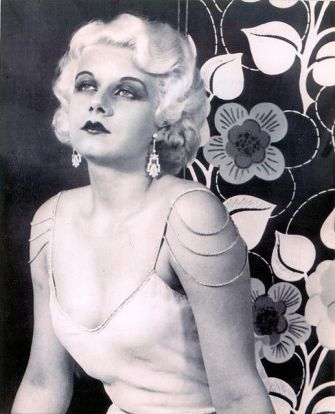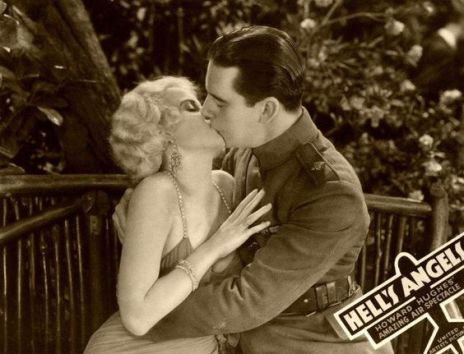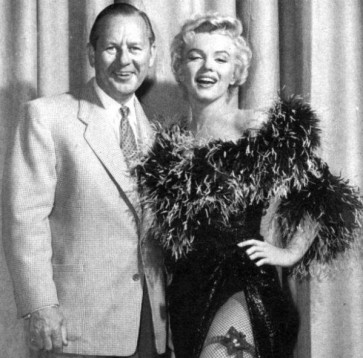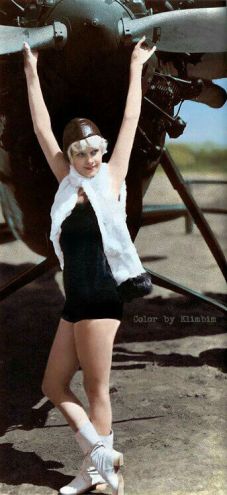
I JUST watched Hell’s Angels. It was about time. Here, I’m not talking about a film on the motorcycle club, but about Howard Hughes film that involves a lot of planes, World War I and, blonde bombshell Jean Harlow.
Because Jean is who we are honouring today, Samantha from Musings of A Classic Film Addict, with our Jean Harlow Blogathon. It took me long to finally pick a subject for the occasion but I thought it would be a good excuse to finally watch Hell’s Angels and write about it if I felt inspired. And it was the case.

Hell’s Angels is a 1930’s pre-code film directed by businessman Howard Hughes. His involvement in the movie industry, plus his love for aviation resulted in what would be one of the most expensive movies of the early 30s. It’s the story of two English brothers, Roy (James Hall) and Monte (Ben Lyon) Rutledge who get enlisted in the Royal Flying Corps (RFC) not long after World War I has been declared and England joined the conflict. This involves certain sacrifices, one of the biggest being that their German friend, Karl (John Darrow), a student from Oxford, has to enlist for the German Army (so, therefore, the opposing side). Karl loves England and hates the idea to fight a place where his friends come from and where he spent a part of his life. Roy has a girlfriend, Helen (played by, you’ve guessed it: Jean Harlow), whom he constantly praises. She isn’t exactly what he thinks she is and will show her true free spirit when seducing (and more…) his brother Monte.

Probably like many people, I first heard of Hell’s Angels by watching Martin Scorsese’s The Aviator. The film tells us about the life of the fascinating but highly complexed Howard Hughes (played by Leonardo DiCaprio). The first part revolves particularly around the making of Hell’s Angels. I immediately loved Scorsese’s film the first time I saw it, and particularly the Hell’s Angels sequence. Leonardo DiCaprio delivers one of his best performances (he should have won the Oscar for that, long before The Revenant). One particularly interesting aspect of the film concern its cinematography: Martin Scorsese gave the film a visual that corresponded to its time period. Therefore, each depicted year in the film looks the way a colour film from that year would look. (IMDB). In the film, Jean Harlow is played by Gwen Stefanie. This might sound like an odd choice but she really doesn’t appear in many scenes so, for such a small role, it works fine. Anyway, I first saw this film when I was perhaps 16 (it was more than 5 years ago, that I’m positive) and, as I was also discovering classic films at the time, it also made me want to see Hell’s Angels. But, the thing is, I finally made up my mind in late February 2019… Yeah… I think I was initially afraid to be disappointed. My verdict is that I should have watched it much sooner.
When Jean played in Hughes’s films, she was only 19 (but looks much older. I didn’t look that glamorous at that age…). And it was among her first important roles. It was, as a matter of fact, her first credited role and the one that gave her star status. Interestingly, the part was initially not given to Jean, but to Norwegian actress Greta Nissen. This was when the film was initially shot as a silent picture. But when they decided to make a talking version, her accent being too strong for the taste of the producers (…) they had to look for a replacement. Jean was spotted by actor James Hall and, after a few screen tests, she got the part. Jean’s role is not the biggest one in the film, but it’s a significant enough one. And, let’s not forget it was her first significant appearance on-screen.

The Jean Harlow from Hell’s Angels is slightly different from the one you’ll find in Bombshell or Libelled Lady. The classy 19 years old starlet had then much “darker” features, despite the platinum blond hair. But I think the eyebrows, which were thicker, as well as the smokey eye make-up, had a lot to do with it. Anyway, she looked absolutely ravishing and I think that kind of gives needed “guts” to her character. I loved her the minute she appears in the film. No, this is not necessarily her best performance, but it’s a more than good one considering she was now truly beginning as an actress in the film industry. She greets us with her absolutely adorable smile and expresses a contagious dynamism, which creates a strong contrast with John Darrow’s character. Jean as Helen is very sure of herself and shows she was on the right track to becoming one of the most well-remembered stars of the 30s. Because Jean Harlow was more than a beauty. She also had a natural talent for acting and people tend to forget it. Jean is the seductress by excellence in this film and shows an impressive maturity for her 19 year-old-self. The character she plays might be seen as one with no morals for some (she cheats on her boyfriend) but could be seen as a sign of liberation for others (or even of feminism). She’s carefree and I loved her that way. Yes, the way she [spoiler] tells her boyfriend that she doesn’t love him is kind of cruel [end of spoiler] but that doesn’t make her a less important and relevant character. She definitely is one of the best things about this film.
Interestingly, Ben Lyon who plays Monte is the one who “discovered” Marilyn Monroe. This was in 1946 and she was then known as Norma Jeane Dougherty. He was struck by her resemblance to her Hell’s Angel’s co-star, Jean Harlow, and organized a color screen-test for her. He finally signed her for a contract as Marilyn Monroe, the name that made her famous. Ben Lyon was then a 20-Century Fox executive. He was one of the rare men who didn’t claim to have had an adventure with the blonde icon. Marilyn has always been thankful for his kindness and for having helped her in her career. (Wikipedia) But even if Marilyn and Jean shared physical similarities, in my opinion, we can distinguish them one from another very easily as they both led strong careers and had their proper acting style. Yes, Marilyn Monroe was a fervent admirer of Jean Harlow, but I never felt she was just “copy” of her.

But let’s come back to Hell’s Angles. I’ve said previously that this was one of the most expensive films of the early 30s. However, it doesn’t “feel” as a big budget film. The high costs might have been due to the plane sequences, the Zeppelin sequence, and the two-strip Multicolor scene. But, overall, despite having been directed by the notorious businessman that Howard Hughes was, there’s a certain simplicity in this film that makes his background production to go unnoticed. It’s nothing like Gone With the Wind or Titanic. The film, yes, focuses on a certain visual spectacle, but its narrativity, its message might be even stronger.
But the visual aspect of Hell’s Angels is, yes, what impresses us the most. I was simply spellbound by some of the scenes and, therefore, this is the kind of film I would totally like to see on big screen. The war planes sequences were shot in a very impressive and modern way, showing us the acting from various and dynamic angles. The shooting was a dangerous one and three of the pilots died during the shooting. Howard Hughes himself flew his own plane for a sequence and risked his life when this one crashed. The planes create an extraordinary choreography. There’s a scene where they fight against the German plane, and it lasts quite a long time but we just don’t want it to stop! Honestly, it almost made me want to fly a plane. But then, I always had a kind of fascination for that. I also liked the fact that these scenes didn’t contain any music. It only accentuates their authenticity and it proves us that a film doesn’t need orchestral music in order to be epic.
I’ve also mentioned a sequence with a Zeppelin. In this scene, Karl (who has now joined the German army) is part of the airship military crew and has for objective to guide them to the center of London to drop the bombs and destroy the city. And this scene shows, once again, Karl’s love for England and his opposition to fighting against it. The Zeppelin floats across the clouds like a big whale in the ocean. Karl is lower down in the cloud in a spy basket to give indications to the crew and let them know when they are in good position to drop the bombs. When they are just above a big lake without any living soul (well, sorry, there might have been a few fishes), Karl make them believe that they are right over Trafalgar Square, their main target. So, they drop the bombs in the lake and they are very proud of themselves. Of course, they can’t see anything as they are above the clouds. They have to rely on Karl. There’s obviously something quite ridiculous about this and Hell’s Angels is another one of these World War I films that shows that the common soldiers didn’t really want to fight and didn’t really have something personal against the supposed “enemy”.
[spoilers] Unfortunately, this scene contains its ups and downs. When the airship is spotted by the English Army from the ground, English planes are sent to attack it. The Zeppelin then has to get lighter in order to gain altitude. So, the German soldiers begin to drop overboard objects that they don’t need and that are unnecessarily heavy, but this is not enough. The commander decides to cut the cable holding the spy basket and Karl has this one is dragging the Zeppelin down. So, Karl, after his heroic act, is precipitated in the void. This scene cuts her breath for a moment. We just think “this can’t be happening” but the way it is executed is kind of hypnotizing. We just see Karl falling down across the sky like a raindrop and it just seems to never end. It’s silent, we don’t hear anyone screaming. It’s a very strange sequence. Things get even stranger when they realize that sacrificing Karl wasn’t enough. The soldiers then accept to jump to their death themselves in order to save the ship and honour the country they are fighting for. So, they just let themselves drop into the emptiness like old rag dolls and people whose brain has been seriously washed. Actually, it almost reminded me of the “Jump!” scene from Lubitsch’s To Be Or Not To Be. The remaining Germans then shot three of the airplanes, including the one piloted the two brothers, but they managed to land without any major injuries. Then Germans think they’re now rid of the English planes and their Zeppelin starts to gain altitude, but they are wrong: there was one English airplane remaining and this one leads them to their fatality when it dives right into the giant monster and makes it explode. Just like the two brothers who observe the spectacle from the ground, we are speechless in front of that unexpected moment. [end of spoilers]
Jean isn’t part of this scene but she was one of the people who was constantly highly impressed by it. She wouldn’t miss an occasion to watch it over and over again.
Hell’s Angels contains scenes filmed with colour filters but also a two-strip Multicolor 8- minutes sequence. This is a much appreciated moment from Hughes’s film as it was our only chance to see Jean in colour. Filming in colour was, at the time, still in an evolving process (attempts to filmed in colour were done since Edison) and it was still quite expensive. The two-strip was a peculiar visual that had nothing to do with Technicolor. Of course, we wished Jean would have lived longer to see her in colour more often. Meanwhile, we can console ourselves with these eight minutes. Our verdict: she’s as gorgeous in colour as she is in black and white.
On its released, Hell’s Angels was praised for its aircraft sequences (how could it not have been? It even resulted in a well-deserved Oscar nomination for Best Cinematography) but the acting from the three main actors received mixed reviews. The New Yorker was particularly critical of Jean’s performance saying of it that it was “plain awful” but we believe they exaggerated. As I’ve said, no it was not necessarily her best performance but it was far from being “awful” and well, we know she far from becoming forgotten after having conquered the eyes of the public.


So yes, Hell’s Angels deserves much more recognition than it has today. If you haven’t seen it, I recommend you to stop waiting and do it as soon as possible. No, it’s not a “perfect” film but it has sufficient elements to make it unforgettable and historically significant. After all, Stanley Kubrick cited it as one of his 10 most favourite films and a great influence!
And for every Harlow’s fans, I obviously consider it a must.
Meanwhile, you can still read the other reviews for the Jean Harlow Blogathon here.
See you!



















[…] at The Wonderful World of Cinema, discuss the film that made Jean a star: Hell’s Angels, directed by the notorious Howard […]
LikeLike
[…] My amazing co-host starts us off with a review of the movie that put Jean Harlow on the map: Hell’s Angels (1930). […]
LikeLike
An excellent analysis as usual Ginny. I always learn so much from your blogs. I never saw the film so I skipped over the spoilers. I didn’t realize it was the movie in” the aviator “. Will try to see it one day.
LikeLiked by 1 person
Thanks for reading Mike!
LikeLike
I haven’t seen this one yet- but I do agree with your comments- this is the Jean before the Blonde bombshell- before her Hollywood Treatment makeover. I have seen a few of Howard Hughes’ productions- the Outlaw, His Kind of Woman, Macao- and I will say- Hughes could cast his actors rights but could NOT write or produce very well- I’m not fond of any of those flicks. I will have to see this one however- like you, its been on my watch list for a long time!
LikeLiked by 1 person
I think on the technical plan this one is worth seeing. Hughes loved aviation and he made it the subject of his film so I trust he knew what he doing. Thanks so much for reading my entry Em!
LikeLike
So interesting Virginie! I didn’t know much about this film, but I think I’ll add it to my watch list now! Jean looks so lovely! As you said, you can already see she was just meant to be a star! Thank you again for co hosting this lovely Blogathon!
LikeLiked by 1 person
This was such an enjoyable read! I can tell how much you appreciated the film and also how much of a good impression it made on you. Hughes was indeed a crazy kind of guy but he made some interesting flicks like ‘Jet Pilot’, another one filled with aviation action. I would personally love to see this and my, Jean looks so beautifully daring in this. She was definitely unlike most 19-year-olds. 😊
LikeLiked by 1 person
I absolutely loved this write-up! I too first wanted to see Hell’s Angels after first watching The Aviator, and you enlightened me to so many things about the film that I didn’t know before. Those Technicolor sequences are so gorgeous, and I didn’t really notice the differences in Jean’s makeup until you pointed it out, but I almost like her look better here. This movie was already on my watchlist, but your awesome review made me want to see this even more! ☺ It was so much fun honoring Jean with you!
LikeLike
This is one of the few Harlow films I have yet to see. Your review has stirred an interest for me.
LikeLiked by 1 person
Hell’s Angels is one of my favorite films. I was completely mesmerized by the air battle scenes – and having no music in them was a great choice – as well as with Jean in color. I’m glad you wrote that she had a great natural talent for acting, which is true. I didn’t known, however, that Ben Lyon discovered Marlyn Monroe.
Thanks for hosting the blogathon!
Kisses!
Le
LikeLiked by 1 person
[…] stylish). So, those plane scenes were pretty impressive, although maybe not as impressive as in Hell’s Angels (Howard Hughes, 1930), in my opinion. And, of course, how can we forget that famous travelling at […]
LikeLike